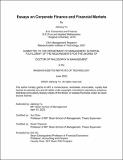Essays on Corporate Finance and Financial Markets
Author(s)
Yu, Jiaheng
DownloadThesis PDF (1.675Mb)
Advisor
Chen, Hui
Thesmar, David
Terms of use
Metadata
Show full item recordAbstract
This thesis consists of three chapters.
Chapter 1 studies the informational role of trade credit and the accounts receivable financing market. I hand collect new data on the contracts of accounts receivable based loans and trade credit terms. I find that sellers experiencing payment delays are primarily financed through accounts receivable based loans. These loans are 2- 4% per year more expensive than buyers’ borrowing rates and require a 20% average haircut on invoice value. Seller moral hazard that leads to bad-quality products is a determinant of payment delays, and although difficult to observe in existing data, can be uncovered from terms of accounts receivable based loans. Lenders help improve the quality of sellers: sellers who successfully receive credit experience a 5% decline in receivable days and have higher sales and longer relationships with buyers. I propose and structurally estimate a trade credit model that incorporates accounts receivable financing. In the model, the buyer trades off the financial cost and the incentive effect of trade credit and learns from the lender’s loan decisions. I show through counterfactual analyses that regulatory limits on payment delays increase the presence of bad products and lower output, while subsidizing accounts receivable financing may increase output at relatively low expense.
In Chapter 2, joint work with Rodney Garratt and Haoxiang Zhu, we study the design of Central Bank Digital Currencies. Banks of different sizes respond differently to interest on reserves (IOR) policy. For low IOR rates, large banks are non-responsive to IOR rate changes, leading to weak pass-through of IOR rate changes to deposit rates. In these circumstances, a central bank digital currency (CBDC) may be used to provide competitive pressure to drive up deposit rates and improve monetary policy transmission. We explore the implications of two design features: interest rate and convenience value. Increasing the CBDC interest rate past a point where it becomes a binding floor, increases deposit rates but leads to greater inequality of market shares in both deposit and lending markets and can reduce the responsiveness of deposit rates to changes in the IOR rate. In contrast, increasing convenience, from sufficiently high levels, increases deposit rates, causes market shares to converge and can increase the responsiveness of deposit rates to changes in the IOR rate.
In Chapter 3, joint work with Jingxiong Hu, we study the effect of “guaranteed close” on the informativeness of market close prices. Passive investment strategies that trade at market close have incurred high transaction fees charged by the primary exchanges. Investment banks undercut the exchanges by executing client orders at close prices set on the exchanges yet charging lower fees. While providing liquidity, banks trade on the order flow information. Using a quasi-experimental shock – an NYSE close auction fee cut – we find that banks’ trading activities improve the informativeness of close prices and reduce the cost of passive investment strategies. To explain this finding, we propose a model where dual trading improves price discovery. A bank contributes to price discovery by trading on the informativeness of the orders it receives relative to the market. The implications of our model apply generally to scenarios with multiple trading venues where venue operators trade on order flow data.
Date issued
2023-06Department
Sloan School of ManagementPublisher
Massachusetts Institute of Technology